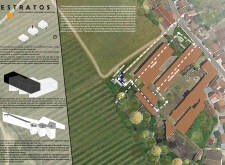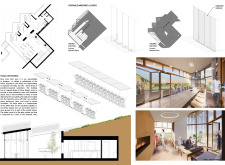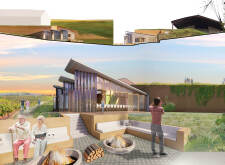5 key facts about this project
Quinta do Monte D'Oiro Wine Tasting Room is located within a vineyard in Portugal, serving as a space for wine tasting and learning. The design centers on the journey of winemaking, establishing a close connection between the building and the landscape. By placing the structure among the vines, the project highlights the significance of place and the experiences related to wine production.
Site Orientation and Design Approach
The building is set at a 45-degree angle to true north, optimizing sunlight exposure. The northeast corner is raised to provide effective roof orientation, enhancing passive solar heating. This arrangement not only supports the building's sustainability goals but also allows natural light to fill the tasting room, creating a welcoming environment.
Spatial Configuration for Flexibility
Inside, a solid service spine houses essential facilities like mechanical rooms, restrooms, and a service bar. This setup streamlines operations and enhances visitor experiences. The tasting room layout allows for flexibility, accommodating both large groups and smaller gatherings. It can be divided into five separate areas, each offering access to outdoor spaces and panoramic views.
Sustainable Climate Control Systems
Sustainability is a central theme in the design, featuring earth tubes and radiant heating systems to maintain comfort indoors. Warm air moves through the earth tubes, using the ground's natural temperature to cool incoming air. This reduces the need for mechanical cooling. In addition, phase change materials within the radiant ceilings help maintain stable indoor temperatures, ensuring comfort throughout the year.
Architectural Elements and Materiality
Rammed earth and natural stone are the main materials used in the design. The rammed earth wall connects the building to its surroundings, reflecting the historical roots of winemaking in the area. Natural stone contributes strength and texture, resonating with the local landscape. The faceted northwest facade captures sunset views. Operable north-facing glass enhances natural light and ventilation, improving the overall experience for visitors.






















































